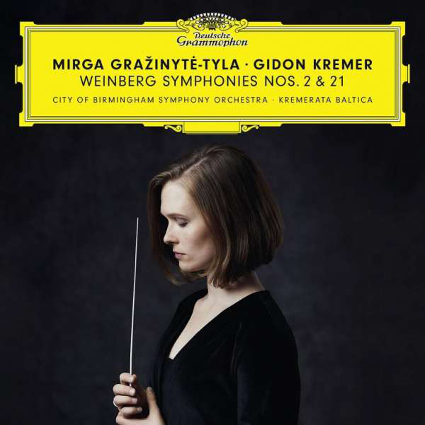This recording of Weinberg’s masterpiece, conducted by Mirga
Gražinytė-Tyla, with the City of Birmingham Symphony Orchestra,
Gidon Kremer and the Kremerata Baltica, comes from the acclaimed live
performance, part of the in-depth CBSO Weinberg series in November 2018.
Though the symphony does get performed and has been recorded once before,
this performance is exceptionally idiomatic as it is made by the finest
specialists in the field, Gidon Kremer and Kremerata Baltica, supported by
Gražinytė-Tyla and the City of Birmingham Symphony Orchestra, in
top form. With these impeccable forces, it is unlikely that this
performance will be surpassed for some time. This belongs in every
collection, Weinberg-focused or not.
The combination of chamber orchestra, soloists and large orchestra is
fundamental to structure and meaning. Embedding the ensemble and soloists
within the orchestra shapes highlights individual voices against a wider
background. In the apocalyptic tumult of the Holocaust, personal utterances
must not be overlooked. This also extends the forces Weinberg can bring to
bear in this panoramic landscape. “It is hard to string this
bow”, said Gražinytė-Tyla of the interaction between
ensemble and orchestra. “The reason is that long passages are
dominated entirely by a solo voice and various chamber ensembles while the
gigantic orchestral apparatus of almost 100 musicians sits on the
stage” resurfacing at different points.
The Largo opens with the plaintive sound of Kremer’s violin, singing,
poignantly, alone. Weinberg could be referencing many sources – the
role of violinists in Eastern European culture, community fiddlers as well
as trained virtuosi. On an autograph manuscript, Weinberg quoted the title
of Mahler’s song Das irdische leben where a child cries out
for bread, but is ignored, and dies. There are also quotes from
Chopin’s Ballade no. 1 in G minor (Op. 23), further anchoring the
Polish context in which Weinberg grew up. With muffled timpani, darker
forces enter. There are moments when Kremer deliberately hardens the tone.
But the violin soars upward, supported by the strings in the orchestra,
before being silenced by a single, harsh drumstroke. The violin resumes
reaching a very high tessitura above the steady pulse in the orchestra,
before quietly subsiding as the orchestra shapes transparent, ethereal
textures. The Allegro molto shatters any illusion of peace. This is graphic
music. Ferocious chords and turbulent crosscurrents, interrupted by
“gunfire” (percussion) and sudden, sharp outbursts of violence.
The Largo is built around a chorale-like anthem. Tense, quiet passages
alternate with more expansive motifs. Kremer’s violin re-emerges,
bold, klezmer-like figures taunting strident, low-voiced brass. The Presto
is manic, screaming alarums and madcap grotesquerie. Yet Kremer’s
violin will not be stilled, its melody restrained but uncowed. As it fades,
the Andantino rises, single notes plucked on violin, answered by the
orchestra. This section is exquisite, executed with great poise, a reminder
of civilized values.
In the Lento, the panoramic landscape of the Largo is redrawn. The violin
is plucked, quietly, against a wash of high-pitched winds – winds
suggesting movement and n the Lento, the panoramic landscape of the Largo
is redrawn. The violin is plucked, quietly, against a wash of high-pitched
winds – winds suggesting movement and change – bells ringing
against ostinato discord, and a soprano voice is heard, singing a wordless
plaint. The soprano is Gražinytė-Tyla herself, who trained as a
singer and came from a music background. She knows how to carry a line, and
the purity of her tone fits perfectly with what the voice might signify.
The part is substantial and quotes passages that Kremer and the other
soloists had played before. At moments her voice deepens richly before
soaring upwards before the piano (Georgijs Osokins), clarinet (Oliver
Janes), violin (Kremer) and double bass (Iurii Gavryliuk) return, the
ensemble raised from the dead, so to speak, reunited with
Gražinytė-Tyla’s song, growing with even greater
affirmation than before. The symphony ends with a mysterious glow in this
extraordinarily sensitive performance. This is a symphony of such
multi-layered depth and subtlety that it rewards attentive listening.
Weinberg’s Symphony no. 2 (Op. 30) may have been written closer to the
time the events described in Symphony no. 21, but traumas like that need
time to process. In any case, Weinberg had to contend with Stalin and the
Soviet authorities. Written for string orchestra, the textures are lighter,
Gražinytė-Tyla conducting the Kremerata Baltica so the lines flow
gracefully. The part for solo violin dominates, leading the ensemble forth.
In the Adagio the violin takes flight. The higher strings follow but are
met by a hushed section for lower strings. The Allegretto is lively:
brightly poised and nicely defined.
Anne Ozorio
